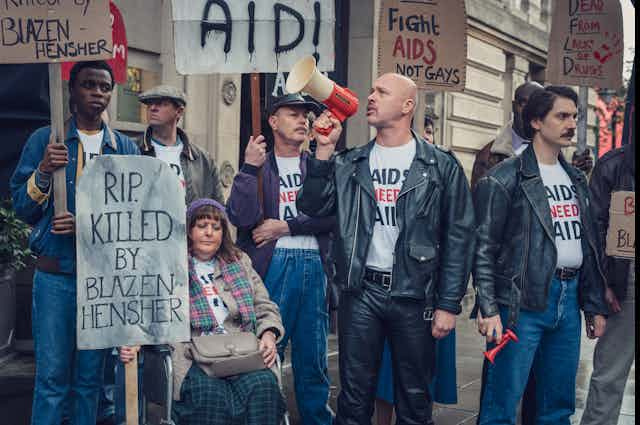It’s a Sin, the Channel 4 series following a group of friends navigating the HIV/Aids crisis in 1980s London, has been a colossal success. With 6.5 million viewers, it has the accolade of Channel 4’s “most binged new series”, and has received high praise from many LGBTQ+ people.
In some ways, this reflects how far the media has come in its portrayal of LGBTQ+ life, and those living with HIV in particular. My new book, written with academics Jose Catalan and Barbara Hedge, tells the story of HIV based on accounts of key players in the epidemic. It highlights how the press contributed to the shocking treatment of people living with HIV in the 1980s and 1990s.
We heard about those with HIV being asked to get out of ambulances and walk to hospital, about offensive graffiti daubed on houses of those suspected of having HIV, and about bricks through windows forcing people to move home. The people we spoke to shared stories of the media’s role in creating and perpetuating this hatred.
People living with HIV were depicted in the press as the dangerous “other”. “Gas gays says Tory”, ran one headline. One doctor told us, “Most of the rather sensational reporting … was around contagion, around gay men, about excluding them and herding them up.”
The impact of media sensationalism on people living with HIV - and even institutions - was of shock and shame. A gay man we spoke to said, “I’d read about it in the papers and had an idea of the facts, but not of the emotions of suddenly being in a ward with 12 people all near death.” Meanwhile, a senior doctor remarked, “I personally was told to give up my interest in HIV, as this was ‘ruining’ the reputation of the hospital.”
The press divided people living with HIV into the “guilty” – those thought to have brought HIV infection upon themselves, like gay men – and “innocent victims” like those with haemophilia who were infected with HIV from donated blood.

Where the NHS tried to create sanctuary for people with HIV, the press would try to invade their privacy. One nurse told us that journalists sometimes posed as visitors to get information about HIV positive patients who were of interest to the press. “They’d come in with a bunch of flowers and say, ‘These flowers are for [well-known person]’ and you’d thank them, and they’d say, ‘So you can confirm that person’s here then?’”
Occasionally, the press had help. A psychologist told us: “Someone in the GP practice had worked out that one of the doctors was positive and had sold the story to a newspaper, but [an HIV] charity helped us overnight successfully to get an injunction to stop the story.”
However, for all the homophobic and negative coverage, one unintentional side-effect of this media sensationalism was the emergence of moving, human accounts from openly gay men and people living with HIV. As one psychiatrist saw it, the fact that “so many articulate, presentable, people with HIV were in the media … had a huge impact in terms of normalising homosexuality and HIV”.
The media today
These stories help us reflect on how things have changed – and how they haven’t. It’s worrying to think how much further behind we’d be today without those brave voices. But of course, discrimination against LGBTQ+ people and those living with HIV didn’t end in the 1980s. Recent coverage of PrEP (pre-exposure prophylaxis), the drug taken by HIV-negative people to significantly reduce chances of getting HIV (dubbed a “promiscuity pill” in some places) shows homophobia, HIV stigma and dogwhistles still exist in the media.
Meanwhile, coverage of trans people today has echoes of that of gay men in the early 1980s. Trans people are publicly debated yet tend to be excluded from these discussions – or face prejudice when they are included. The way they are often portrayed as a potential threat is reminiscent of the way gay men were smeared as threats to the public.
Nevertheless, the change in attitudes towards LGBTQ+ people means a show like It’s A Sin can not only be made in the first place, but can also be wildly successful. This reflects the importance of allies – and the positive role the media can play. As the famous Aids slogan insisted, “silence equals death”, and allyship is about telling and hearing personal stories to develop compassion and positive change.
Like the character Jill in It’s a Sin, the allies of the 1980s and 90s believed in supporting gay people and those living with HIV, they accepted who they were. In our book, we conclude that the allies of this time were the “people (who) moved in a counter direction to the tide of stigma and negative attitudes in sections of the media and community”.
Jose Catalan, co-author of HIV in the UK - Voices from the Epidemic, contributed to writing this article.

